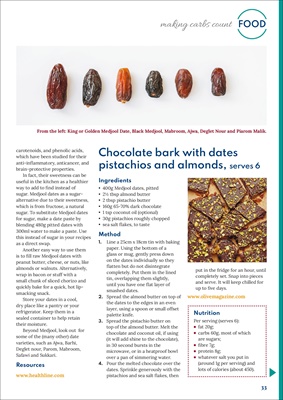
33
FOOD
making carbs count
Tiptrees'
Nutrition
Per 50g fruit:
Energy 21 cals;
Carbohydrates 5g;
no fat, salt, protein or fibre
but some decent dollops of
micronutrients;
Potassium, 4% RDA;
Copper 3%;
Thiamin (B1) 3%;
Vitamin C 3%);
Vitamin E (3%);
Iron 2%.
Nutrition
Per 100g fruit
Energy 43 cals;
Carbohydrates 10g;
No fat or salt.
Potassium 5% RDA;
Fibre 6%;
Vitamin C 60%;
Iron 10%;
Vitamin B6 5%;
Magnesium 4%.
As for how to eat them, heir
natural sweetness makes them
perfect for just as they are but they
are an incredibly versatile fruit. Use
them in crumbles, pies, jams and
chutneys. They tend to be sweeter
and more spherical than plums.
These vibrant green plums are
prized for their rich, honey-like
flavour and slightly tart finish.
Perfect for snacking, baking, or
making preserves, greengages offer
a unique treat that plum lovers
adore for their exquisite balance of
sweetness and tang.
Mulberries
These are flowering plants in the
family Moraceae, consists of 19
species of deciduous trees commonly
known as mulberries, growing
wild and under cultivation in many
temperate world regions. While
the mulberry is a tree belonging to
the Moraceae family (also including
the fig, jackfruit, and other fruits),
raspberries and blackberries are
brambles and belong to the Rosaceae
family, so despite looking the same,
they are not related. Immature fruits
are white, green, or pale yellow. The
fruit turns from pink to red while
ripening, then dark purple or black,
and has a sweet flavour when fully
ripe. Famously, the dark colour stains
fingers when picking the fruit and
can take a while to disappear! They
make a delicious jam.
Mulberry leaves, particularly
those of the white mulberry, are
ecologically important as the sole
food source of the silkworm (Bombyx
mori, named after the mulberry
genus Morus), the cocoon of which is
used to make silk.